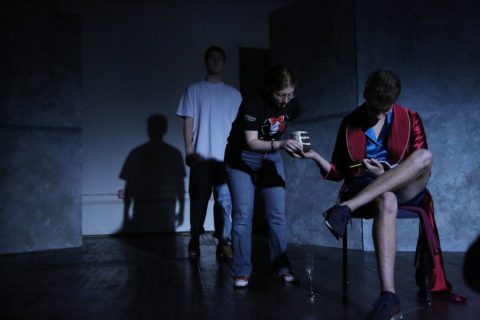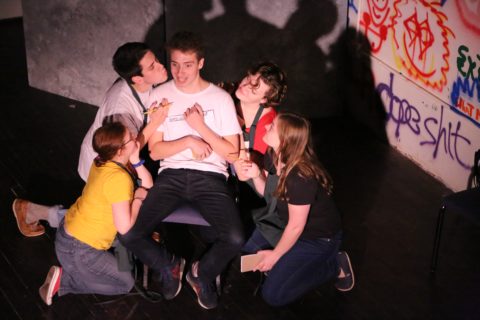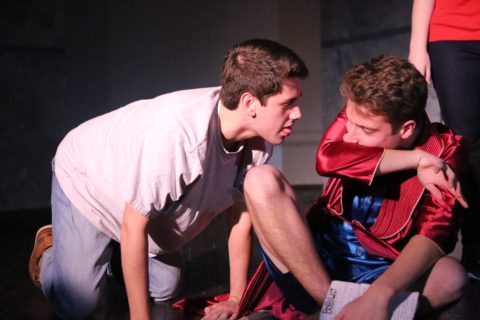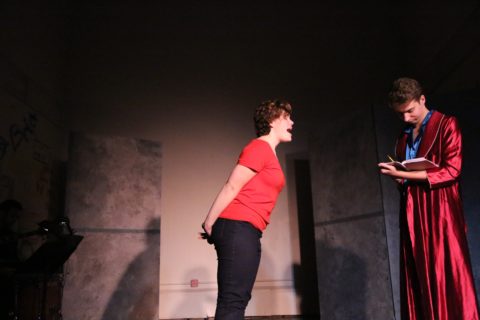Last weekend I had the pleasure of attending a production of Peter Sinn Nachtrieb’s Bob, directed by Jason Karos. I was not disappointed.

Bob lived in his mansion with his butler (played by Dara Pohl Feldman ’18) and three prostitutes that he hired, feeling an emptiness that he did not know how to fulfill. Bob eventually decided to erect a plaque with his name on it, stating that he was a great man, and thus concluding his childhood fantasy.
To get it out of the way, the venue: Bob was held in the Barn, which was profoundly unpleasant. While temperatures may be rising globally, they can’t get high enough to make sitting in a room with no heat for three hours in December comfortable. Plus, due to the illogically low number of rented seats, I had to sit on a mat. I’m not gonna pretend that was fun. What’s wrong with Oliva, guys?

Bob’s adopted mother died suddenly when he was 12, leaving him to fend for himself. He lived alone at a rest stop for awhile, until one day he decided to hop in the trunk of a car and travel the nation. In his travels, he met many wacky characters who taught him more valuable lessons about life. Photo by Taryn Gangi ’20
The plot of Bob centers around the life of its eponymous protagonist. From his birth and subsequent abandonment in a White Castle bathroom, to his adoption by a kind-hearted employee of the burger joint, who takes him on a series of escalating adventures before dying suddenly, Bob’s story is thoroughly fantastic. faces legal action after burning his foster mother’s corpse and later runs into an ex-lover of hers, who gifts him a ring initially intended for her. Bob travels across America and engages in a series of wild misadventures, ranging from adding a new head to Mount Rushmore, getting his pants stolen by his own biological mother, owning a pet wolf, training animals, and experiencing miraculous luck at roulette. In the third Act, he is witness to his father’s gruesome murder by a pack of hungry wolves. Not to spoil the ending, but ultimately Bob realizes that his true purpose lies in the telling of his epic tale.

Photo by Taryn Gangi’ 20
Bob’s production values were generally good. The musical accompaniment was smooth. The show’s sparse staging was both an effective means by which to tell the story, and fertile opportunity for enjoyable on-stage improvisation. However, some aspects of the production were a bit off-putting. Firstly, there were the dance breaks. After each act was a segment in which a dancer took the stage for three to five minutes and performed a piece without context. While the second dance number, performed by Erin Fagan, was deeply moving (the guy next to me was crying) I found the general lack of relation between the dancing and the arc of Bob’s story obfuscating. Costume design was, no pun intended, seamless, and the economy displayed was not at all jarring, but rather more useful than over-the-top, low quality costumes that frequently typify amateur efforts in dramaturgy.

Bob eventually became rich when he stopped in at a casino and guessed correctly 17 times in a row during a game of roulette. He bought the property which held the casino, and built himself a mansion to live in.
On the one hand, Bob provided an authentic off-broadway feel–its production value was high given its relatively low budget and avant-garde staging. On the other hand, some of the acting detracted from the experience. While Dara Pohl Feldman’s performance as the Chorus and Oliver O’Neil’s performance as Bob were perfectly serviceable, several cast members failed to emote. All in all, though, its minor flaws were not enough to impune Bob in the eyes of faithful viewers, and the production proved far superior to most student-directed shows I have been forced to endure. Should you get the chance to see a reprise, I would highly recommend taking advantage of that opportunity.









